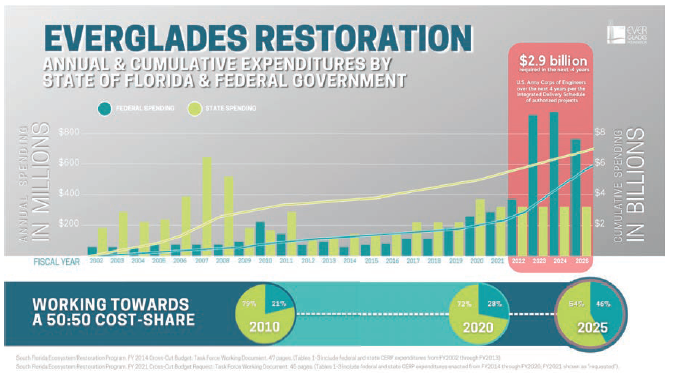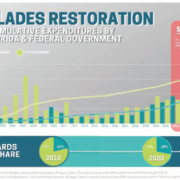Florida Can’t Wait
by Eric Eikenberg, CEO of The Everglades Foundation
When it comes to investing in Everglades restoration, Washington seems about to meet its responsibilities to share the cost with the State of Florida. It’s a good decision. Consider the returns from Washington’s investing now in Everglades restoration:
- Economists calculate that the massive public works projectscalled for as part of Everglades restoration will create upwards of 47,000 new jobs – jobs that will be critical as Florida rebounds from COVID-19
- Restoration will protect the pillars of south Florida’s Clean Water Economy: tourism, real estate and recreation
- The restoration projects will rescue a globally-significant ecosystem and World Heritage Site
- Restoration will help recover threatened and endangered species like the Everglade snail kite
- Th e projects will help manage water and habitat resiliency in the face of sea level rise
- Just as two decades of delay has led to higher costs, investing in restoration now will reduce the ultimate cost by accelerating completion of the projects
- These investments will accomplish long overdue modernization of south Florida’s water infrastructure
Florida’s water management infrastructure – the “Centraland Southern Florida Project” – was designed in 1948. It was a different time and a different Florida: an agriculture based economy with a total population of 2.5 million people, just over10% of today’s population.
Since the postwar years, the population of south Florida has swelled to nine million. Our region has evolved from a farm based economy to one based on tourism, real estate and water based recreation like beaches, boating and fishing – all highly reliant on clean water.
The bipartisan Comprehensive Everglades Restoration Plan (CERP) that was signed into law in2000 will bring Florida’s water infrastructure into the 21stCentury, protecting our jobs, our property and our modern economy.
Over the past 20 years, the state of Florida has outspent the federal government on restoration projects by nearly 3 to 1. In order to complete authorized projects that are currently outlined in the Army Corps of Engineers Integrated Delivery Schedule (IDS),the federal government must more than double its commitment to Everglades restoration over the next five years. By doing so, the federal government will save billions of dollars in overall program costs.
A robust federal investment, made early, will accelerate key projects like the Central Everglades Plan (including the Everglades Reservoir south of Lake Okeechobee) and key storage projects to the east (C-44 St. Lucie Reservoir) and west (C-43Caloosahatchee Reservoir) of Lake Okeechobee.
Collectively, these projects will protect south Florida’s world class coastal fisheries, reduce wildfire in the Everglades, protect the drinking water supply for all of us in south Florida and provide greater flexibility to manage water during floods, droughts, hurricanes and in the face of sea level rise.
The graph below shows the annual and cumulative CERP program expenditures by the State of Florida and the federal government between 2002 and 2021. Extending state funding forward for the next four years, and assuming the $320 million/year made by Governor Ron DeSantis and the Florida Legislature, state spending for CERP will total approximately $6.5 billion by 2025. If the federal government commits the $2.9 billion needed by the U.S. Army Corps of Engineers over the next four years, we can complete key Everglades Restoration projects and greatly increase the federal cost-share of CERP.





Leave a Reply
Want to join the discussion?Feel free to contribute!